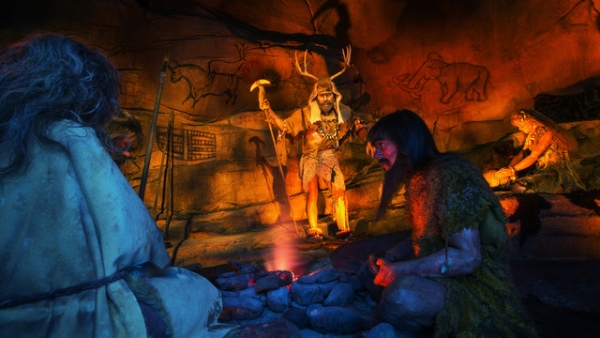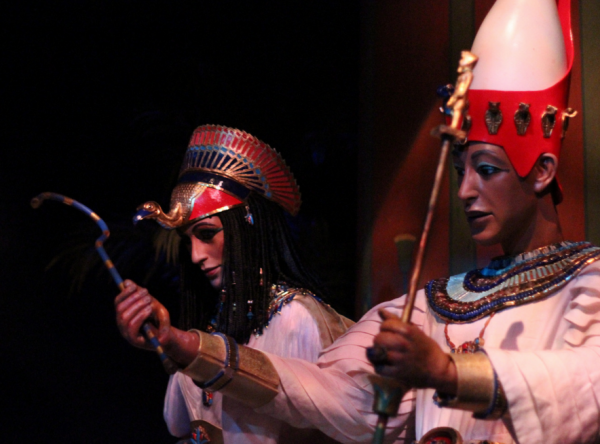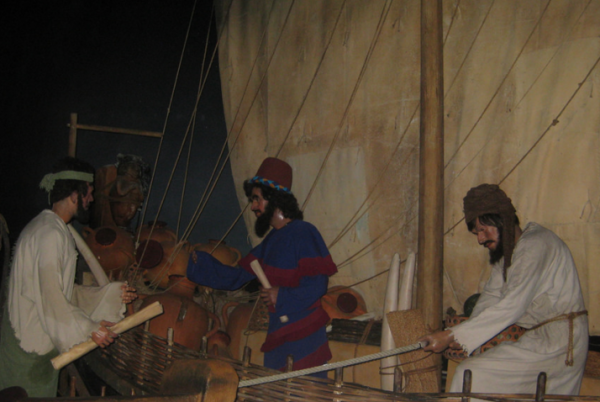
Spaceship Earth is a journey through the history (and prehistory) of human communication. It’s a Disney favorite, loaded with animatronic wonders and impressive Imagineering design. Perhaps most importantly, it’s housed in the amazing and iconic geodesic dome that represents Epcot to the world.
But as you climb aboard the time machine, it’s probably a good idea to warn your kids that the history they’re about to hear is only moderately accurate.
That’s because the script, as presented magnificently by Dame Judi Dench, skims and skips over an awful lot of actual historic fact. Yes, much of what’s said in the script is sort of true if you don’t dig too deeply – but if you scratch the surface you notice a few questionable statements.
Here are 7 points in the Spaceship Earth story that don’t quite fit the facts.
1. Humans went from basic communication to cave drawings in 15,000 years
Image: Disney
Here in this hostile world is where our story begins. We are alone, struggling to survive until we learn to communicate with one another. Now we can hunt as a team and survive together. It takes 15,000 years to come up with the next bright idea: recording our knowledge on cave walls. There is only one small problem, when we move, the recorded knowledge stayed behind.
We aren’t told when the story begins, so it’s hard to know which 15,000 years Dame Judi is talking about. But – assuming that we’re all good with the idea of human evolution--it’s really pretty unlikely that people went from basic communication and hunting in groups to cave painting in just 15,000 years.
Evidence suggests that early humans (not necessarily Homo sapiens) were sitting around campfires more than a million years ago – something that would be very tough to do without communication. According to the Smithsonian, there is even evidence that our human ancestors were butchering their meat and burying their dead more than 200,000 years ago. Clearly, our forebears were doing some pretty sophisticated thinking and communicating.
And it was 40,000 years ago (to our certain knowledge) people were painting on cave walls (on the Indonesian Island of Sulawesi). ) 40,000 years is a long way (chronologically speaking) from 200,000 years ago, or from our next stop in ancient Egypt – which was a world power just 5,000 years ago…
2. Egyptians invented paper which led to the "Dawn of Great Civilizations"
Now let's move ahead to ancient Egypt, because something is about to happen here that will change the future forever. This unknown Egyptian pounding reeds flat is inventing papyrus, a sort of paper. Papyrus in turn creates better record keeping of plans, designs and unfortunately taxes. But it also brings with it the dawn of great civilizations.
This part of the script certainly seems to be suggesting that paper, along with record-keeping and great civilizations, was invented (or at least set in motion) by some unknown Egyptian.
Papyrus did come from Egypt, but paper as we know it (made from rag and fiber) was invented in China.
More significantly, however, neither the Egyptians nor the Chinese invented writing on objects other than cave walls. That was done much earlier by Sumerians who wrote in Cuneiform, a system of writing that used V-shaped images pressed into wet clay. While clay tablets weren’t as easy to carry or roll as papyrus or paper, they certainly provided major civilizations (which came before the Egyptian civilization) with the ability to record information.
3. The first basic alphabet was invented by the Phoenicians
Image: Ben Ostrowsky, Flickr (license)
At this point each civilization has its own form of writing which none of the others can understand. But the Phoenicians, who trade with all of them, have a solution. They create a simple common alphabet adaptable to most languages. Remember how easy it was to learn your ABC's? Thank the Phoenicians, they invented them.
There’s a little truth and a little exaggeration in this bit of the script. According to the Encyclopedia Britannica, the very first real alphabet was the North Semitic alphabet, developed in Syria around the 11th century BC. It included 22 letters (all consonants) and, like our alphabet, was written from left to right. This was the forerunner of what is called the Phoenician alphabet.
Did the Phoenicians really invent an alphabet at all? Some historians say yes, while others disagree. What we do know is that the Phoenicians, who traded with civilizations all around the Mediterranean and beyond, were key to spreading the use of a common alphabet around the globe.



Comments
Wow, excellent feature! Thanks for all the information.